2-3 Syracuse
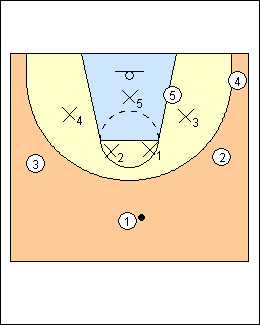 | 1 Jim Boeheim Five defenders must move on every pass, contest three-point shots with everything you have (it does open up gaps, adjust to penetration). It's all ball position, wherever the ball is, they want to be in the same position every time, they don't care where cutters or post players are. Play a 3-2 zone without moving the centre out of the middle. Stay in the zone even if the other team makes a couple of 3's, that can be good, move up, more pressure, make them take tougher shots. When playing man, zone out of bounds plays to see what they do against a zone. Play zone at the end of the game, outside shots are harder with the game on the line, you are less likely to foul and the other team is probably in the bonus. In transition after pressing (to change tempo), don't run back to the basket, run back to the 3-point line, find the shooters. |
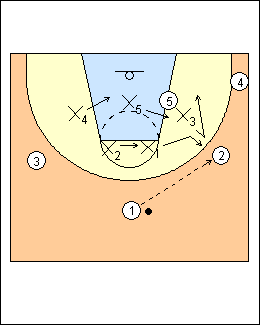 | 2 Defenders have their hands out wide. The two guards should be able to touch hands with arms out. The forwards are out and up a bit, causing the illusion that a defender is there. Key to the defence is covering 3 perimeter guys with 2 defenders, with help from the forwards. If one perimeter attacker doesn't shoot well, cheat off him. They don't designate who picks up the ball, or care which way 1 goes. On a pass to the wing, the forward comes up as though he is going to the play the ball, the guard comes over flat enough to take away the drive, then the forward moves back. If 2 drives baseline as X3 is moving up, X3 (the forward who gets beat) will trap in the short corner with X5, see below. With shooter 4 in or cutting to the corner, centre 5 will tell X3 to bump back. |
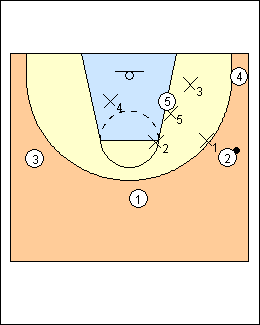 | 3 With the ball on the wing, X2 covers the elbow, X5 fronts the low post, X1 pressures the ball. coachesclipboard.net - X3 covers the low block with the ball on the wing. |
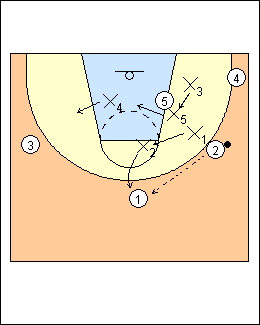 | 4 On a pass out top, X2 takes the ball, X1 covers the high post. X2 closes out on an angle that forces shooter 1 back towards help. X2 stays back if 1 is not a shooter. If X1 is late and 2 drives baseline, X3 will only fake and recover if 4 is a shooter, X5 has to stop 2. As soon as a skip pass is made, everyone moves. If 2 skip passes to 3, X2 would bump back X4. |
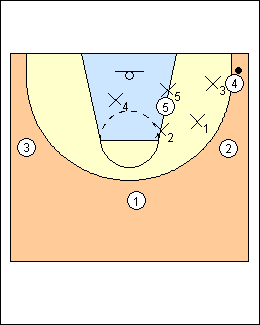 | 5 With the ball in the corner, X1 drops and X5 steps down a bit. The weakside forward is always key to their defence, X4 is worried about a skip pass to 3, not about an inside attacker. If they're trapping, X1 goes right with a pass to corner, see below. |
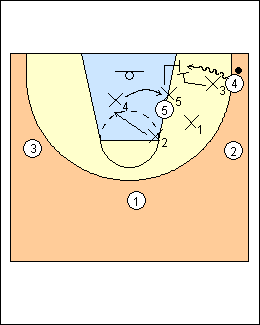 | 6 If X3 gets beat baseline it's an automatic trap. 4 is normally thinking about scoring, if he's thinking about passing it's usually to 5, which is why X4 is the key to the defence, he has to get 5, X2 takes the backside, if it's a good trap X1 may be able to get out and look for a steal. |
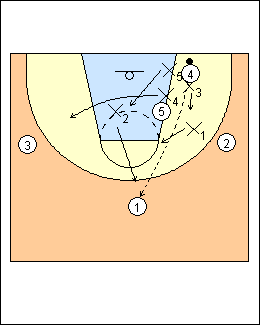 | 7 The most likely pass is to 1, they don't want to gamble too much, they don't mind if the offence throws it out, X2 closes out, tight on a shooter, short on a driver. X4 has to get back to 3. |
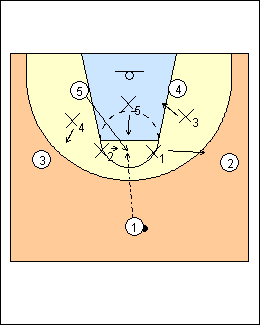 | 8 Rule - the centre is responsible for the ball any time it goes to the high post. If there is a post flash by 5 for a pass (the guards are split too wide), X3 fronts 4, X5 and X2 take the ball, X1 takes shooter 2, X4 is concerned about 3 (he has no one). The shot from the high post is not bad for the defence, the ball is in the middle and they have rebounding position. |
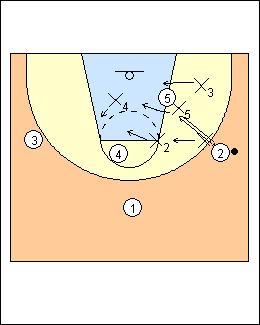 | 9 Rebounding A shot from the wing often results in a weakside 2 on 1. X4 does not block out 3 or 4, he gets position. Centre X5 does not block out, he comes back to the middle. Weakside guard X2 comes back to help, X1 takes a long rebound. If the other team is rebounding hard, it does help set up your fast break, and if they are rebounding hard on the weakside, they aren't attacking you as much ballside. |
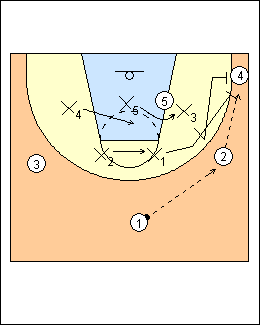 | 10 Corner trap The corner trap is key to keeping the ball out of the corner. They trap the corner a lot, except maybe if the other team can handle it, but they aren't going to tell you, and may trap when you sub in. On a pass from the wing to the corner, the forward is bumped back ready to attack the ball, X1 comes right down to trap with X3. |
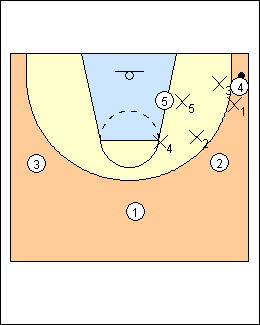 | 11 Weakside guard X2 covers the passing lane back to the wing, X4 is the key defender, he has to cover any high post attacker or the point guard (it's hard to get him to do it). X5 always fronts the low post, even if there is no low-post attacker. 3 on the far wing is left open. Fraschilla - X4 looks for a cross-court pass that has "helium" in it. |
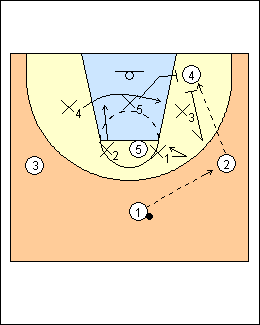 | 12 Short-corner trap When they get beat, it's usually in the short corner (by gambling up on a shooter on the wing, the short corner is vulnerable). Syracuse will normally trap a pass to the short corner (especially to a shooter), ballside forward X3 moves back and center 5 moves out to get the short-corner trap. The guards plug ballside and weakside, the weakside forward must come across the lane to defend a high post rolling to the basket, it's the hardest rotation. Don't let 4 split the trap, they just want him to throw the ball out of the short corner then they get back to their normal positions. Fran Fraschilla (espn.go.com) - the short corner is open temporarily when X3 bumps up. Syracuse will trap a pass to the short corner with X3 and X5. |
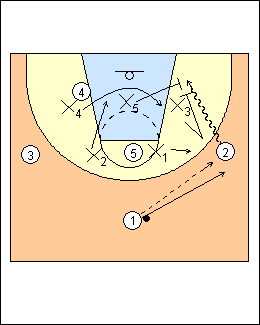 | 13 It's the same trap if 2 beats X3 on a baseline drive, X4 comes across, both guards plug in, or X1 will stay close to a three-point shooter. |
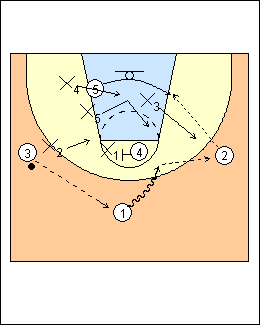 | 14 Against screens This is a good offensive play, 4 screens X1, 1 drives, X5 comes up, 1 kicks to 2, X2 goes out on 2 and stays to take away a three-point shot, 2 passes inside to 5. If X1 gets beat on that screen they're in trouble, he must get over the screen, moving up as soon as he sees it, even way up, he doesn't care if 1 goes back the other way. |
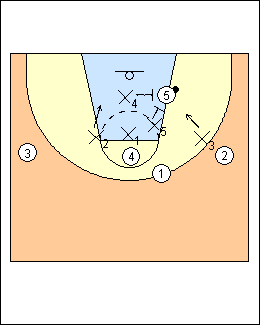 | 15 Weakside X4 has to get 5, X5 comes down to help. |
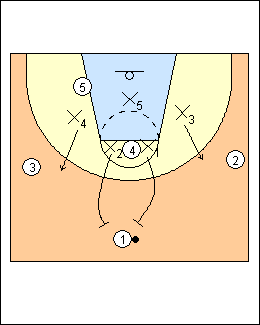 | 16 Halfcourt trap Once a half, maybe, or the other team's point guard is very weak or very strong (get the ball out of his hands). The guards come out to trap the ball as it crosses centre. The forwards rotate up in the passing lanes to the wings, Syracuse may let the center gamble and come up on a high post. |
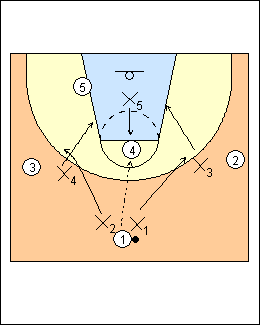 | 17 On a pass to the high post, the forwards drop to the basket, the guards take the wing shooters (4 doesn't usually look for 1), the centre starts up if 4 is going to be a shooter. If they know that 4 will put it on the floor, the guards will come back looking to get the ball. |
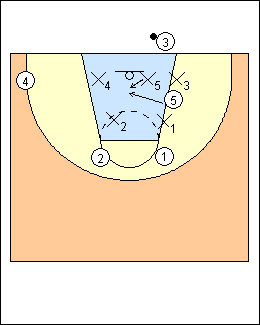 | 18 Baseline inbounds X4 can't allow an inbounds pass to the weakside corner, X5 can protect inside a little bit, if an attacker comes into the basket area he has it. X3 and X1 will trap an inbounds pass to the ballside corner, they encourage that. Most teams will have 1 go back for a pass over the top, sometimes Syracuse will let X2 release and try to get that pass. Very few times does someone score against their inbounds zone. Bob Hurley - zone baseline out of bounds the first two times (worried about layups), then man after that (worried about 3-point shots). Put 4 on the ball, 5 in the middle near the basket, 3 takes away opposite corner, 2 is ballside, 1 weakside. They want the ball to come in ballside, trap with 4 and 2, 5 covers the low post, 1 covers the next pass (shoot the gap), 3 covers the ballside elbow. Playing man, switch any lateral screen or screen around the basket, fight through on the perimeter. |
This page was made with Basketball playbook from Jes-Soft